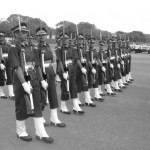It is not clear as to when the idea or perhaps the concept of a limited war was first evolved and articulated in the Indian military. May be it was the fallout from the procrastination, dithering and timidity in our response and an alibi for the missed opportunity of a suitable riposte to a major mischief by Pakistan at Kargil. Such response would have put an end to the slow bleeding of India by Pakistan. Or was it the result of the fiasco of ‘Operation Parakaram’ (mobilization of Indian defence forces consequent to the attack on Indian Parliament) where we thought we could go in for a limited war and then backtracked on conjuring up the prospects of a larger conflagration and the nuclear overhang!.
It is easy to start a war but difficult to conclude it on own terms”¦The American war in Afghanistan is a case in point.
It takes minimum of two contestants to make war. Therefore, both must subscribe to the idea of a limited war. It cannot work when one of the contestants does and the other does not fall for it. Then there is the issue of both scale and duration of the conflict. Here again there is the problem of the two adopting the same concept and course of action. There is also the hazardous undertaking of forecasting and then chartering the future course of a war and preparing for just that one contingency.
It is easy to start a war but difficult to conclude it on own terms. German army after nearly two decades of study, planning and preparation and detailed knowledge of every inch of ground over which operations were to be conducted prepared the Schlieffen Plan and catered for no other contingency. With over 350 army divisions it undertook to over run France in 40 days during the First World War. The war lasted four years with disastrous consequences for Germany. The American war in Afghanistan is a case in point.
Coming to the specifics of the Indo-Pak setting and context, neither side is willing to concede territory.
The second issue relates to a conflict between two nuclear armed contestants. The parameters and compulsions for either side to transcend from conventional war to a nuclear war are not that simple or easy to overcome. A whole range of considerations and possible consequences come into play, especially if the opponent has the wherewithal, will and the capacity to completely devastate and lay waste the whole of the country. Consequently in such a setting the conflict will remain within the bounds of conventional warfare. Then there is the inevitable issue of reaching a stage ( also sometimes called ‘threshold’) where the very survival nay the existence of the nationcomes into play when a fatal decision to go nuclear can be considered. Sooner than later world pressure is likely to prevail in ending the conflict.
Coming to the specifics of the Indo-Pak setting and context, neither side is willing to concede territory. This has led to extensive obstacle systems being created by both sides close to the border and these are effectively held. Consequently major battles will be conducted within a few kilometers on either side of the border. Such was the case in 1965 and 1971 on the Western Sector. That has been and will remain the dominant reality of a conflict between these two neighbours. It is here along the plains of J and K and Punjab, where the centre of gravity of the two countries lie, more so of Pakistan, and it is here that the decisive battles, if and when they occur, will be fought.
Clausewitz records that, “˜war is continuation of policy but there has to be a “˜policy to carry forward to war. Sometimes there can be a conflict or variance between policy and war aim”¦
The second and more important issue relates to meshing together the military and political aims of a war. These two cannot work in isolation or exclusion of one from the other. While Clausewitz records that, ‘war is continuation of policy’ but there has to be a ‘policy’ to carry forward to war. Sometimes there can be a conflict or variance between policy and war aim. In such situations it is the bounden duty of the military commander to lay bare before those who formulate national policy the full implications of pursuing a policy which is at variance with military aim. More so where issue of victory and defeat or those less compelling, yet have far reaching implications exist.
If in the considered opinion and conviction of the military commander, he figures being compelled to adopt a course other than what is in national interest and interest of his army, he should quietly make way for some one else. Had the then army chief in 1962 told some home truths about the state of his army and military infrastructure and offered to quit, the political leadership would have seen the light and India spared that humiliation and army the ignominy of a rout, enormous loss of life and the untold suffering.




